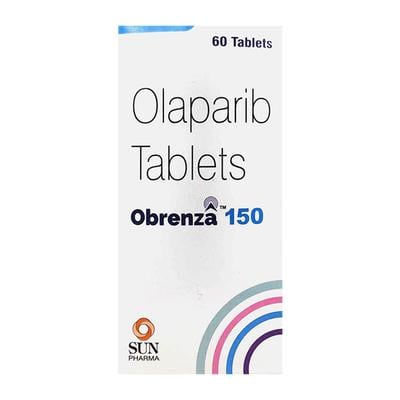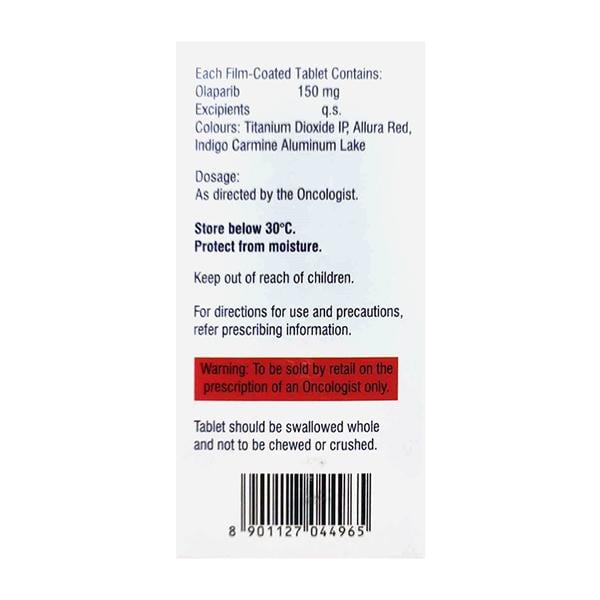

Netmeds First Membership
Quick Links
Introduction About OBRENZA 150 TABLET
OBRENZA 150 TABLET is a medicine used to manage certain types of ovarian, breast, uterine, prostate, and pancreatic cancers, especially in people with BRCA gene mutations. It helps slow down or stop cancer from growing and is often given after chemotherapy to reduce the risk of cancer coming back. Doctors prescribe it as a maintenance treatment to help keep cancer under control for a longer time.
This medicine works by blocking a protein called PARP, which cancer cells use to repair themselves. When PARP is blocked, cancer cells struggle to survive and eventually die, making the treatment more effective. Olaparib comes in tablet form and is usually taken twice a day, with or without food. It's important to swallow the tablets whole and take them at the same time every day. If you forget a dose, just take the next one as scheduled—do not take an extra tablet to make up for the missed dose.
Before starting OBRENZA 150 TABLET, tell your doctor if you are pregnant, planning to become pregnant, or breastfeeding, as this medicine can harm the baby. Women should use effective birth control during treatment and for some time after stopping the medicine.
OBRENZA 150 TABLET is not recommended for children and should be used with caution in people with liver or kidney problems. Some common side effects include feeling tired, nausea, vomiting, diarrhea, and low red blood cell levels (anemia), which may cause dizziness or weakness. If you experience severe side effects like breathing problems, fever, or signs of infection, contact your doctor immediately. Always follow your doctor’s instructions carefully for safe and effective therapy.
Uses Of OBRENZA 150 TABLET
It is used in the management of cancer caused due to gene mutation (BRCA-mutated, HER2-negative) such as:
- Ovarian cancer
- Breast cancer
- Pancreatic cancer
- Prostate cancer
- Uterine cancer
Benefits of OBRENZA 150 TABLET
Olaparib is a targeted cancer therapy designed to help slow down or stop the growth of certain cancers. It works by blocking an enzyme called PARP, which helps cancer cells repair themselves. By stopping this repair process, olaparib makes it harder for cancer cells to survive, leading to their destruction.
Who Can Benefit from Olaparib?
Olaparib is mainly used for patients with specific genetic mutations (such as BRCA mutations) and is prescribed for the following cancers:
- Ovarian Cancer – Helps stop cancer from coming back after chemotherapy, especially for patients with BRCA or HRD mutations.
- Breast Cancer – Used in certain types of HER2-negative breast cancer to lower the risk of recurrence or to slow down cancer that has spread.
- Prostate Cancer – Beneficial for patients with advanced prostate cancer who have not responded to other treatments.
- Pancreatic Cancer – Helps maintain the response to chemotherapy in some patients with inherited BRCA mutations.
Key Benefits of OBRENZA 150 TABLET:
- Slows Down Cancer Growth – Helps stop cancer from spreading and may shrink tumors.
- Extends Cancer-Free Period – In some cases, it prevents cancer from coming back after therapy.
- Oral Medication – Easy to take at home, reducing the need for frequent hospital visits.
- Targeted Therapy – Works specifically on cancer cells, reducing harm to normal cells.
How OBRENZA 150 TABLET Works
OBRENZA 150 TABLET is a type of targeted cancer therapy called a PARP inhibitor. It works by stopping cancer cells from repairing themselves.
Our body naturally repairs damaged DNA (genetic material) to keep cells healthy. Cancer cells also use this repair system to grow and survive. Olaparib blocks an enzyme called PARP (poly ADP-ribose polymerase), which cancer cells rely on to fix their DNA.
When PARP is blocked, the cancer cells become weak and eventually die, especially in people with BRCA mutations or certain genetic conditions that make cancer cells more dependent on PARP for survival.
This makes olaparib effective in managing cancers like ovarian, breast, prostate, and pancreatic cancer, especially in patients with specific genetic changes.
How to use OBRENZA 150 TABLET
It is important to follow your doctor's instructions when taking OBRENZA 150 TABLET to ensure its effectiveness and minimize potential side effects.
- Your doctor will determine the exact dosage based on your specific condition. Always take OBRENZA 150 TABLET exactly as prescribed.?
How to Take OBRENZA 150 TABLET:
- Take OBRENZA 150 TABLET with a glass of water, with or without food. Do not chew, crush, dissolve, or divide the tablets, as this may affect how the medicine is absorbed by your body.
- OBRENZA 150 TABLET is typically taken twice a day, once in the morning and once in the evening.?
- Try to take your doses at the same times each day to maintain an even level of the medication in your body.?
Duration of Therapy:
- Continue taking OBRENZA 150 TABLET for as long as your doctor prescribes. Do not stop taking it without consulting your doctor, even if you feel well.?
What if I forgot to take OBRENZA 150 TABLET
- If you forget to take a dose, take your next dose at the scheduled time. Do not take an extra dose to make up for the one you missed.?
Side Effects Of OBRENZA 150 TABLET
OBRENZA 150 TABLET causes certain side effects in some individuals, although not everybody gets them.
Common Side Effects of OBRENZA 150 TABLET are:
- Nausea, vomiting
- Tiredness, weakness
- Indigestion or heartburn, loss of appetite, diarrhea, upper stomach pain
- Headache, Changes in taste of foods
- Dizziness, cough, shortness of breath
- low white blood cell counts which may be associated with fever
- Skin rashes
- Mouth ulcers (stomatitis)
- Low blood platelet counts causing bleeding or bruising
- Increase in blood creatinine - this test is used to check how your kidneys are working
- Abnormal liver function tests
When to Seek Medical Attention?
Stop taking OBRENZA 150 TABLET and consult your doctor immediately if you experience any of the following side effects:
- Pneumonitis (signs include shortness of breath, coughing and wheezing)
- Signs of blood clots such as pain or swelling in an extremity (blood clot in legs), shortness of breath, chest pain, breathing that is more rapid than normal or heart beats faster than normal (pulmonary embolism)
- Signs of liver problems (such as unexplained nausea, vomiting, yellowing of your skin or the whites of your eyes, abnormally dark or brown urine, pain at right side of the stomach area (abdomen), tiredness, less hunger)
- Signs of anemia (such as shortness of breath, feeling very tired, pale skin or fast heartbeat)
- Severe allergic reactions (such as skin rashes, itching, difficulty in breathing or swallowing, dizziness)
- Itchy rash or swollen, reddened skin (dermatitis)
- Bone marrow problems (such as myelodysplastic syndrome or acute myeloid leukaemia)
Warning & Precautions
Pregnancy
ContraindicatedOBRENZA 150 TABLET should not be used in pregnant women as it may affect the unborn baby. Women of child-bearing potential must use effective contraceptive method to avoid pregnancy while taking OBRENZA 150 TABLET and until 6 months after stopping the therapy. If you accidentally became pregnant while taking OBRENZA 150 TABLET, talk to your doctor immediately.
Breastfeeding
ContraindicatedIt is not known whether OBRENZA 150 TABLET passes through the breast milk. Therefore, do not breastfeed if you are taking this medicine and for 1 month after taking OBRENZA 150 TABLET. Confirm with your doctor about when you can breastfeed after stopping OBRENZA 150 TABLET.
Driving and Using Machines
Use with CautionDo not drive or operate any heavy tools or machineries if you feel dizzy, weak or tired after taking OBRENZA 150 TABLET.
Kidney
Use with CautionOBRENZA 150 TABLET should be used with caution in patients with moderate to severe kidney disease. Therefore, inform your doctor if you have any pre-existing kidney conditions as a precaution.
Liver
Use with CautionOBRENZA 150 TABLET should be used with caution in patients with liver diseases. Therefore, consult your doctor before taking it.
Allergy
ContraindicatedDo not take OBRENZA 150 TABLET if you are allergic to Olaparib.
Use In Pediatrics
Consult your doctorThere is no proper information regarding the use of OBRENZA 150 TABLET in children and adolescents (aged below 18 years). Therefore, consult your doctor for advice.
Use In Geriatrics
Use with CautionOBRENZA 150 TABLET should be used with caution in elderly patients. Therefore, consult your doctor for advice.
Other Warnings for OBRENZA 150 TABLET
Before taking OBRENZA 150 TABLET, inform your doctor if you:
- have clots in blood vessels
- Low RBC, WBC or platelet levels in blood
Drug - Drug interaction
-
Medications That May Increase OBRENZA 150 TABLET Levels:
- Antifungal Agents: Drugs like fluconazole can raise the amount of OBRENZA 150 TABLET in your blood, potentially leading to more side effects. It's advisable to avoid using fluconazole while on OBRENZA 150 TABLET. If it's necessary to take both, your doctor might adjust your OBRENZA 150 TABLET dose to 200 mg twice daily.
-
Medications That May Decrease OBRENZA 150 TABLET Levels:
- Certain Seizure Medications: Drugs such as phenytoin, carbamazepine, and phenobarbital may lower OBRENZA 150 TABLET levels, making it less effective.?
- Antibiotics: Rifampicin, used to treat infections like tuberculosis, can also reduce OBRENZA 150 TABLET's effectiveness.?
- Herbal Supplements: St. John's Wort, often used for depression, may decrease OBRENZA 150 TABLET levels.?
If you're taking any of these medications, inform your doctor. They may adjust your treatment plan to ensure OBRENZA 150 TABLET remains effective.?
Drug - Food interaction
- Grapefruit and Seville Oranges: Consuming these fruits or their juices can increase OBRENZA 150 TABLET levels in your blood, raising the risk of side effects. It's recommended to avoid these while on OBRENZA 150 TABLET.?
More Information
Storage
- Store olaparib tablets at below 30°C (86°F) in a cool, dry place. Avoid exposure to direct sunlight, heat, and moisture.
- Always store the tablets in their original blister pack or bottle to protect them from humidity and damage.
- Store the medication in a secure place out of reach of children and pets to prevent accidental ingestion.
- Check the expiration date on the packaging and do not use olaparib if it has expired.
- If you no longer need olaparib or it has expired, do not throw it in household waste. Ask your pharmacist how to safely dispose of unused medicine.
Bottom of Form
FAQs About OBRENZA 150 TABLET
Q: What is OBRENZA 150 TABLET used for?
A: OBRENZA 150 TABLET is a targeted cancer therapy used to treat ovarian, breast, uterine, prostate, and pancreatic cancer, particularly in patients with BRCA gene mutations. It helps slow cancer growth and is often prescribed as a maintenance therapy to stop cancer from returning after chemotherapy.
Q: How does OBRENZA 150 TABLET work in cancer therapy?
A: OBRENZA 150 TABLET is a PARP inhibitor that blocks the PARP enzyme, which helps cancer cells repair their DNA. By preventing this repair, Olaparib weakens and destroys cancer cells, making the therapy more effective in patients with genetic mutations like BRCA1 and BRCA2.
Q: How should I take OBRENZA 150 TABLET?
A: OBRENZA 150 TABLET is usually taken twice daily as a tablet, with or without food. The tablets should be swallowed whole, not crushed, split, or chewed. If you miss a dose, do not take a double dose—just take the next one at the scheduled time.
Q: What are the common side effects of OBRENZA 150 TABLET?
A: Some common side effects of OBRENZA 150 TABLET are nausea and vomiting, fatigue (tiredness), diarrhea or constipation, anemia (low red blood cells), causing dizziness or weakness and decreased appetite. If severe side effects like breathing problems, fever, or infections occur, contact your doctor immediately.
Q: Can I take OBRENZA 150 TABLET during pregnancy or breastfeeding?
A: No, OBRENZA 150 TABLET is not safe during pregnancy as it may harm the unborn baby. Women should use effective birth control during treatment and for some time after stopping the medicine. It is also not recommended while breastfeeding, as it may pass into breast milk.
Q: What foods should I avoid while taking OBRENZA 150 TABLET?
A: Avoid consuming grapefruit and Seville oranges (including their juices), as they can increase Olaparib levels in your blood, raising the risk of side effects.
Q: Can OBRENZA 150 TABLET interact with other medications?
A: Yes, Olaparib can interact with certain drugs, such as:
Fluconazole (antifungal) – may increase Olaparib levels
Phenytoin, Carbamazepine (seizure medications) – may reduce effectiveness
Rifampicin (antibiotic) – may lower Olaparib levels
St. John’s Wort (herbal supplement) – should be avoided
Always inform your doctor about all medicines and supplements you are taking.
Q: How long should I take OBRENZA 150 TABLET?
A: The duration of therapy treatment depends on your cancer type, response to therapy, and doctor’s recommendation. Do not stop taking Olaparib without consulting your doctor, even if you feel better.
Q: Is OBRENZA 150 TABLET safe for children?
A: No, OBRENZA 150 TABLET is not approved for use in children. It is only prescribed for adults with specific types of cancer.
References
- Olaparib. Safety Information. [Updated on November 2024]. [Accessed on 25th March 2025].

- Olaparib. Prescribing Information. U.S. Food and Drug Administration. [Updated on November 2024]. [Accessed on 25th March 2025].

- Olaparib. Macmillan Cancer Support. [Revised in November 2023]. [Accessed on 25th March 2025].

- Olaparib. Astrazeneca. July 2021. [Accessed on 25th March 2025].

- Olaparib. EMC. UK. [Revised in June 2024]. [Accessed on 25th March 2025].











